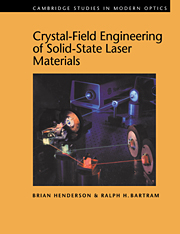Book contents
- Frontmatter
- Contents
- Preface
- 1 An introduction to lasers
- 2 Symmetry considerations
- 3 Optical crystals: their structures, colours and growth
- 4 Energy levels of ions in crystals
- 5 Spectra of ions in crystals
- 6 Radiationless transitions
- 7 Energy transfer and excited state absorption
- 8 Covalency
- 9 Engineering the crystal field
- 10 The crystal field engineered
- References
- Index
6 - Radiationless transitions
Published online by Cambridge University Press: 24 September 2009
- Frontmatter
- Contents
- Preface
- 1 An introduction to lasers
- 2 Symmetry considerations
- 3 Optical crystals: their structures, colours and growth
- 4 Energy levels of ions in crystals
- 5 Spectra of ions in crystals
- 6 Radiationless transitions
- 7 Energy transfer and excited state absorption
- 8 Covalency
- 9 Engineering the crystal field
- 10 The crystal field engineered
- References
- Index
Summary
Physical principles
The present chapter is concerned with transitions between optical levels of point imperfections in solids in which energy is conserved by emission of phonons rather than photons. Such transitions can introduce an undesired loss mechanism in laser materials which competes with stimulated emission, but they also play an essential role in the performance of laser materials, since excited states reached in electric-dipole-allowed pumping transitions subsequently relax to metastable lasing states by a sequence of radiationless processes.
Radiationless transitions are, paradoxically, both ubiquitous and elusive. They are the rule, rather than the exception, following optical excitation; yet, they are inaccessible to direct observation. Radiationless relaxation is generally inferred from its consequences, including such familiar phenomena as radiant heating and the absence of luminescence. In favourable circumstances, the observation of luminescence with diminished intensity and duration provides more detailed information about radiationless processes. Quantitative understanding of some aspects of radiationless relaxation has also proved elusive, in that theory has been more successful in elucidating trends than in the prediction of absolute transition rates. Radiationless transitions generally belong to one of two categories: static processes which are thermally activated from a metastable state, and dynamic processes which occur during rapid relaxation immediately following excitation [Bartram (1990)]. Point imperfections in solids provide examples of both categories.
Prepared state
Radiationless transitions can only occur between non-stationary states of a system; thus the radiationless transition rate depends critically on the sort of non-stationary state which is prepared in a given experiment.
- Type
- Chapter
- Information
- Crystal-Field Engineering of Solid-State Laser Materials , pp. 177 - 193Publisher: Cambridge University PressPrint publication year: 2000



